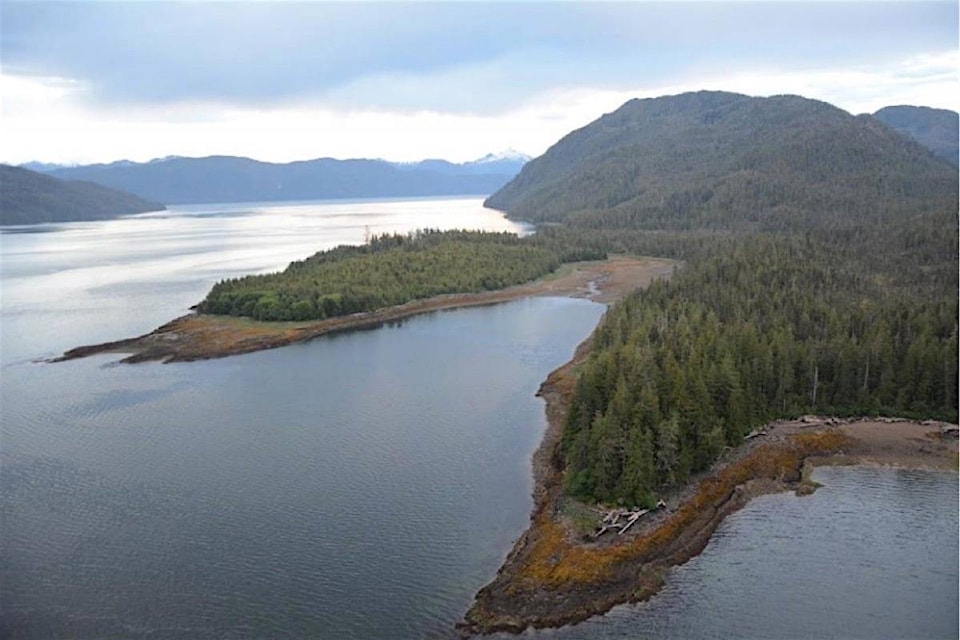With an estimated $55 billion in economic impacts over a projected 30-year lifespan, a proposed floating liquefied natural gas (LNG) project on lands owned by the Nisga’a Nation off of the north coast offers much potential for the Nisga’a, the region and the country, says Nisga’a Lisims Government president Eva Clayton.
But for every benefit there are as many questions surrounding the Ksi Lisims LNG project, she acknowledged.
“It’s still very early days,” Clayton said last week following an initial filing of project information with the British Columbia Environmental Assessment Office, the provincial agency which examines projects and passes the findings to the provincial cabinet for decision-making. “There are a lot of moving parts.”
Here’s what’s known so far:
— Ksi Lisims, which translates as “from the Nass”, is a partnership between the Nisga’a Nation, a collection of seven B.C. and Alberta natural gas producers banding together calling themselves Rockies LNG and a group of LNG-experienced entrepreneurs called Western LNG based in Houston, Texas. Western LNG has no production facilities of its own and this would be its first venture. The exact ownership structure of Ksi Lisims has not been released.
Clayton said the Nisga’a received a number of inquiries beginning in 2014 when it actively began promoting its coastal lands for their LNG export terminal possibilities.
“They offered the best potential,” she said of Rockies LNG and Western LNG.
— The project location is called Wil Milit on the north end of Pearse Island which is fee simple land owned by the Nisga’a Nation and within a broader area of influence outlined in the Nisga’a Treaty of 2000. It’s 15 kilometres from the Nisga’a village of Gingolx at the mouth of the Nass River and just two kilometres south of the B.C.-Alaska border.
— At a planned 12-million tonnes of LNG a year, Ksi Lisims would be just a bit smaller than the 14-million tonnes a year capacity of the LNG Canada facility now under construction at Kitimat. Its market, like LNG Canada, would be Asia and its selling point, also like LNG Canada, would be its nearness to its market.
— Ksi Lisims is promoting itself as a “net zero” project in terms of emissions and is partially basing that on connecting to the BC Hydro hydro-electric power grid. That would require a power line connection either from BC Hydro’s Skeena Substation near Terrace or a substation in the Nass Valley. Preliminary work has started on this aspect. Ksi Lisims says this line would be owned by a third party and not be part of its own project.
— Natural gas would be pumped through a pipeline from northeastern B.C., infrastructure that would not be built by Ksi Lisims but by a third party. Two potential pipeline routes have already been approved for projects once proposed near Prince Rupert but which have since been shelved.
— The construction workforce would number in the thousands and an extensive accommodation facilities would be required, much like the one for the LNG Canada workforce. Preliminary plans call for workers on site, at a camp on the mainland near Gingolx or located in Terrace or Prince Rupert. Approximately 200 people would be needed once the facility begins operating.
— Based on a schedule filed with the initial project description, Ksi Lisims anticipates concluding the environmental approval process in 2024 followed by a decision to proceed with construction and production to begin in late 2027.
And here are some key points:
— The Nisga’a Nation along with the provincial and federal governments will be a partner in the project’s environmental assessment. “That’s unique,” said Clayton of provisions within the Nisga’a Treaty giving the Nisga’a Nation a key role in judging the project’s impacts.
— A deal with a pipeline builder must be reached to pump natural gas from northeastern B.C. TC Energy’s Prince Rupert Gas Transmission’s 48-inch in diameter pipeline and Enbridge’s Westcoast Connector Gas Transmission 36-inch in diameter pipeline with a potential second pipeline have already been permitted from the northeast through Nisga’a lands to the coast.
But both were intended to turn south once reaching the coast and proceed underwater to surface at now-shelved proposed LNG plants near Prince Rupert. Should Ksi Lisims reach a deal with one of those companies, environmental assessments and engineering will be needed to instead turn northward to Pearse Island.
The original deal struck between the Nisga’a Lisims Government and TC Energy for Prince Rupert Gas Transmission, for example, contained specific business opportunities for the Nisga’a in return for the line going through the Nisga’a Memorial Lava Bed Park.
Clayton said the Nisga’a will revisit the economic benefits potential stemming from pipeline construction.
The Prince Rupert Gas Transmission deal did include the option of smaller lines feeding off the main one to provide natural gas to the four Nisga’a villages in the Nass Valley.
— The Wil Milit location may be owned in fee simple by the Nisga’a but other First Nations have also said they have lands and title interest in the area. In initial meetings to date, the Metlakatla First Nation and the Lax Kw’alaams Band asserted their rights.
“I can’t speak to the Metlakatla and Lax Kw’alaams,” said Clayton but she emphasized Ksi Lisims has had and will continue to engage other First Nations regarding the project.
Given the size of the project and its economic benefits, Clayton said there are possibilities of including other First Nations in its development.
